Old Architecture in Amsterdam - Historic Buildings in Amsterdam
There's lots and lots of ages-old architecture in Amsterdam. The oldest historic buildings in Amsterdam (e.g. the Old Church) date back to the 13th century. A stroll through the old city centre can be the equivalent of an introductory lesson to Dutch architecture.
In Amsterdam, each century has left its unique hallmark on the city landscape. Amsterdam may be famous for its "signature buildings" - the colorful 17th century merchants' mansions along the canals - but its range of architecture is actually much broader.
This page covers the 13th to the 17th century. For architecture in Amsterdam from the last 3 centuries, please see our other page about Amsterdam architecture.
Architecture in Amsterdam: 13th to 15th centuries
As a consequence of the two Great Fires that have destroyed major parts of the city in 1421 and 1452, only a small part of Amsterdam's medieval architecture has survived till today. Among those, the majority are stone built edifices. Following the 1452 destructive blaze, the authorities prohibited the use of wood as a material in constructions.
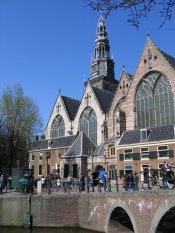
Old Church
However, in the old centre at Begijnhof 34, we can find the Houten Huis, the oldest wooden house dating from around 1420. The Begijnhof complex itself dates from 1346 and was home to the Begijntjes, a community of Catholic sisters. Its small square is dominated by the English Church (Engelse Kerk), built in the 15th century.
The oldest remaining building of the city is the Oude Kerk (Old Church). Located in the heart of the Wallen quarter (today's Red Light District), the Old Church was built around 1250 as a Catholic church. Since its inauguration in 1306 by the Bishop of Utrecht the church has been subject of many extension works, the most radical of them occurring during the Reformation of 1578. Apart from changes in the architecture, the church became Protestant then. Until the 19th century, the church served as the burial place of many famous inhabitants.
The Old Church is famous for its wooden vault, the largest medieval vault in Europe and for its floor made of gravestones (the church is built on a cemetery). It is also known as the location of many concerts and exhibitions such as the annual World Press Photo event. The Old Church's tower offers a spectacular view of the city and can be visited from April until September. Opening hours and entrance fees: www.oudekerk.nl
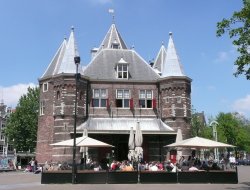
De Waag, Nieuwmarkt square
Next to the Wallen, the Waag, a massive medieval building that dominates the Nieuwmarkt square, is reminiscent of the old city wall for which it served as a gateway. Built in 1488, it houses a restaurant today. It is worthy of a visit because of its hidden attractions, such as the old surgeon's theatre "theatrum anatomicum" on the upper floor. Public dissections were performed here in the 17th century.
The Nieuwe Kerk (New Church), situated at Dam Square (next to the Royal Palace) was erected in 1380 in order to replace the Oude Kerk. The latter was too small for the growing population of Amsterdam. It is here that many royal weddings and coronation ceremonies have taken place, among which the coronation of Queen Beatrix (1980). The New Church also hosts exhibitions and concerts throughout the year and the remembrance ceremony that precedes the commemoration of Liberation Day (May 5th). Opening hours and entrance fees: www.nieuwekerk.nl
Architecture in Amsterdam: 16th century
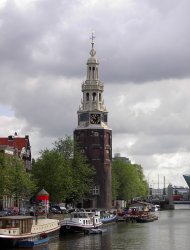
Montelbaanstoren
Most of the 16th century architecture in Amsterdam is located in the vicinity of de Wallen. At Zeedijk 1 - a street lined with pubs and cafés that was originally a part of Amsterdam's fortifications- lays one of the two surviving Amsterdam houses with a wooden facade that was built in the mid-16th century.
One of the landmark buildings of Amsterdam outside the tourist circuit is the Montelbaanstoren. The stone section of the tower was erected in 1512 and for protection purposes. The timber top was added in 1606 by Hendrick de Keyser.
During the Dutch Golden Age, the Montelbaanstoren was the meeting place for sailors that would embark on the ships bound to sail to the East Indies. The tower is not open for public but it hosts the offices of the Amsterdam water authority.
Architecture in Amsterdam: Golden Age (17th century)
The epitome of Dutch Golden Age architecture is represented by the rows of gabled houses lined along the three main canals of the grachtengordel (circle of canals): Herengracht, Prinsengracht and Keizersgracht. In the 17th century, these houses belonged to rich Amsterdam merchants. Today, they are offices of banks and cultural organizations, as well as homes of the well-to-do.
One of the beautiful mansions open to the public is the Van Loon Museum at Keizersgracht 627. Dating from 1672, the house was first the residence of one of Rembrandt's most famous pupils, painter Ferdinand Bol. Along with the beautifully decorated interiors many paintings, porcelain, silver and original furniture are on display. The interior garden, designed after a 17th century map of Amsterdam, makes for a quiet retreat. Opening hours and entrance fees: www.museumvanloon.nl
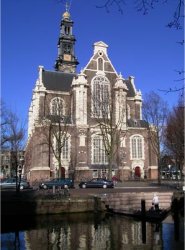
Westerkerk
A remarkable edifice dating from the 17th century is the Westerkerk at Prinsengracht 279. It boasts the highest tower of the city (85 m/272 ft) and a larger nave than any other Dutch Protestant Church. Westerkerk is also Rembrandt's burial place, however his tomb has never been found. Many tourists are attracted to the magnificent view it offers from its tower on a clear skied day. Opening hours and entrance fees: www.westerkerk.nl
The Royal Palace (Paleis op de Dam) is a culmination of 17th century style architecture in Amsterdam, and one of the city's must-see landmarks. Originally it was the city hall of Amsterdam after the Dutch Republic gained its freedom from the Habsburg empire, but later the Dutch monarchy annexed the building. After a thorough renovation, it's now open again for the public. Inside you can find many lavishly decorated rooms, art and the beautiful main hall (Citizens' Hall), whose marble floor is decorated by world maps and a huge statue of Atlas. Opening hours and entrance fees: www.paleisamsterdam.nl
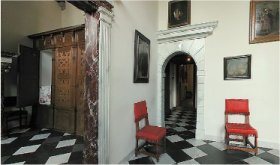
Rembrandthuis, interior
The Rembrandthuis (Jodenbreestraat 4) is the memorial house where Holland's most famous painter Rembrandt lived and worked from 1639 to 1656. It's bound to be an attraction spot for both history and art lovers. The house dates from 1606 and its interior was faithfully restored and refurbished according to the inventory left by the painter when he was forced to sell the house due to bankruptcy Opening hours and entrance fees: www.rembrandthuis.nl
The clandestine Catholic Chapel at the Begijnhof, completed in 1680, is a representative testimony of Amsterdam's religious life as it is the place where Catholic worshipers gathered in secret before 1795 when religious tolerance was fully introduced in the city. It can be visited, but to keep noise at a minimum no tour groups are allowed.
Missing items in this overview of architecture in Amsterdam? Please contact us.
Related Pages:
- Introduction to 18th, 19th and 20th century Amsterdam architecture
- About the rich history of Amsterdam
- What are the leading Amsterdam attractions?
- More attractions in Amsterdam
- Introduction to Amsterdam culture
- Amsterdam guide: basics Amsterdam information
- From architecture in Amsterdam back to Amsterdam Advisor

 Subscribe To
Subscribe To
